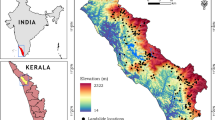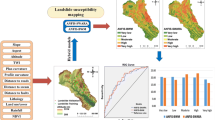Abstract
The main purpose of this study is to investigate the use of hierarchical fuzzy inference systems (HFISs) in expert-based landslide susceptibility mapping in a data-scarce region. Taounate-Ain Aicha and Tahar Souk regions in the central part of the Rif Mountains in Morocco were selected as the case study area. The research was performed in three main stages: (i) the landslide inventory of the region was produced and the conditioning factors were evaluated; (ii) the theoretical background for HFIS was introduced; and (iii) different types of structures and methods of HFIS were investigated in the construction of expert-based models; the landslide information was only used for validation of the expert-based models in this stage. Regarding the inference methods, the defuzzification-free hierarchical fuzzy system (DF-HFS) has not only the remarkable advantage of low cost of computation but also preservation of information. The most successful result was acquired from the model developed using HFISs, which was designed by considering a defuzzification-free hybrid structure with standard membership functions. This research is the first study in which HFISs are evaluated in expert-based landslide susceptibility mapping. HFISs and the rule-generation algorithm implemented in this study will allow fuzzy systems to be applied effectively not only in landslide susceptibility mapping but also in other geoscientific and geo-engineering solutions.











Similar content being viewed by others
Change history
23 July 2019
The published version of this article unfortunately contained a mistake.
References
Aja-Fernandez S, Alberola-Lopez C (2008) Matrix modeling of hierarchical fuzzy systems. IEEE Trans Fuzzy Syst 16(3):585–599. https://doi.org/10.1109/TFUZZ.2007.905905
Akgun A, Sezer EA, Nefeslioglu HA, Gokceoglu C, Pradhan B (2012) An easy-to-use MATLAB program (MamLand) for the assessment of landslide susceptibility using a Mamdani fuzzy algorithm. Comput Geosci 38(1):23–34. https://doi.org/10.1016/j.cageo.2016.10.001
Aleotti P, Chowdhury R (1999) Landslide hazard assessment: summary review and new perspectives. Bull Eng Geol Environ 58(1):21–44. https://doi.org/10.1007/s100640050
Azzouz O, El Fellah B, Chalouan A (2002) Processus de glissement dans le Massif de Bokoya (Rif interne, Maroc): exemple de Cala Bonita. Bulletin de l’Institut Scientifique, Rabat, section Sciences de la Terre 24:33–40
Brenning A (2005) Spatial prediction models for landslide hazards: review, comparison and evaluation. Nat Hazards Earth Syst Sci 5:853–862. https://doi.org/10.5194/nhess-5-853-2005
Campello RJGB, Von Zuben FJ, Amaral WC, Meleiro LAC, Maciel Filho R (2003) Hierarchical fuzzy models within the framework of orthonormal basis functions and their application to bioprocess control. Chem Eng Sci 58(18):4259–4270. https://doi.org/10.1016/S0009-2509(03)00309-9
Chacón J, Irigaray C, Fernández T, El Hamdouni R (2006) Engineering geology maps: landslides and geographical information systems. Bull Eng Geol Environ 65(4):341–411. https://doi.org/10.1007/s10064-006-0064-z
Chalouan A, Michard A, El Kadiri K, Negro F, Frizon de Lamotte D, Soto JI, Saddiqi O (2008) The Rif Belt. In: Michard A, Saddiqi O, Chalouan A, Frizon de Lamotte D (eds) Continental evolution: the geology of Morocco: structure, stratigraphy, and tectonics of the Africa-Atlantic-Mediterranean triple junction. Springer, Berlin, pp 203–302
Cherkassky V (1998) Fuzzy inference systems: a critical review. In: Kaynak O, Zadeh LA, Türksen B, Rudas IJ (eds) Computational intelligence: soft computing and fuzzy-neuro integration with applications. Springer Berlin Heidelberg, Berlin, Heidelberg, pp 177–197. https://doi.org/10.1007/978-3-642-58930-0_10
Corominas J, van Westen C, Frattini P, Cascini L, Malet JP, Fotopoulou S, Catani F, van DenEeckhaut M, Mavrouli O, Agliardi F, Pitilakis K, Winter MG, Pastor M, Ferlisi S, Tofani V, Hervás J, Smith JT (2014) Recommendations for the quantitative analysis of landslide risk. Bull Eng Geol Environ 73:209–263. https://doi.org/10.1007/s10064-013-0538-8
Cruden DM, Varnes DJ (1996) Landslide types and processes. In: Turner AK, Schuster RL (eds) Landslides investigation and mitigation, special report 247, p 36-75
El Alaoui MA, Chefchaouni YC, Diouri M (1964) Geological Map of Taounate-Ain Aicha Region. Notes et Memoires du Service Géologique du Maroc Editions, Rabat, Maroc, No: 166
El Fahchouch AN, Ait Brahim L, Mastere M, Abdelouafi A (2010) Weight of evidence model based on GIS to evaluate landslides susceptibility in central Rif of Morocco. Proceedings of the 4th IASME / WSEAS International Conference on Geology and Seismology (GES '10), Cambridge, p 180-183
El Fellah B, Azzouz O, Assebriy L (1996) Sikha d’Asfalou : exemple de glissement de terrain littoral sur la côte méditerranéenne des Bokoya entre Torrès et Badis. (Rif, Maroc).ORSTOM, réseau érosion, bull. 16:222-230
El Gharbaoui A (1981) La terre et l’Homme dans la peninsula tingitane: Etude sur l’Homme et le milieu dans le Rif occidental. Travaux de l’Institut Scientifique, série Géologie et Géographie Physique, Rabat, 15, 439 p
El Kharim Y (2002) Etude des mouvements de versants dans la région de Tetouan (Rif occidental): inverntaire, analyse et cartographie. Thèse de doctorat d’Etat ès sciences. Univ. A. Essaadi, Tetouan. 201 p
El Khattabi J, Carlier E (2004) Tectonic and hydrodynamic control of landslides in the northern area of the Central Rif, Morocco. Eng Geol 71(3-4):255–264. https://doi.org/10.1016/S0013-7952(03)00137-6
Ercanoglu M, Gokceoglu C (2002) Assessment of landslide susceptibility for a landslide-prone area (north of Yenice, NW Turkey) by fuzzy approach. Environ Geol 41:20–730
Fares A (1994) Essai méthodologique de la cartographie des risques naturels liés aux mouvements de terrain : application à l’aménagement de la ville de Taounate (Rif, Maroc). Thèse de Doctorat, Université de Franche Comté, France, 177 p
Fell R, Corominas J, Bonard C, Cascini L, Leroi E, Savage WZ (2008) Guidelines for landslide susceptibility, hazard and risk zoning for land-use planning. Eng Geol 102(3-4):99–111. https://doi.org/10.1016/j.enggeo.2008.03.022
Feng G (2006) A survey on analysis and design of model-based fuzzy control systems. IEEE Trans Fuzzy Syst 14(5):676–697. https://doi.org/10.1109/TFUZZ.2006.883415
Fonseca A, Catalao J, Zezere JL, Madeira J, Fellah B (2013) Identification of active deep-seated landslides in the Central Rif Mountains through PSI, hotspot and cluster analysis. ESA Living Planet, Edinburgh
Guillaume S (2001) Designing fuzzy inference systems from data: an interpretability-oriented review. IEEE Trans Fuzzy Syst 9(3):426–443. https://doi.org/10.1109/91.928739
Guzzetti F, Carrara A, Cardinali M, Reichenbach P (1999) Landslide hazard evaluation: a review of current techniques and their application in a multiscale study, Central Italy. Geomorphology 31:181–216. https://doi.org/10.1016/S0169-555X(99)00078-1
Guzzetti F, Reichenbach P, Ardizzone F, Cardinali M, Galli M (2006) Estimating the quality of landslide susceptibility models. Geomorphology 81:166–184
Jamshidi M (1997) Large-scale systems: modeling, control and fuzzy logic. Prentice-Hall. Inc, Upper Saddle River 578 p
Kanungo DP, Arora MK, Sarkar S, Gupta RP (2009) Landslide susceptibility zonation (LSZ) mapping-a review. J S Asian Stud 2(1):81–105
Kóczy L, Hirota K (1993) Approximate reasoning by linear rule interpolation and general approximation. Int J Approx Reason 9(3):197–225. https://doi.org/10.1016/0888-613X(93)90010-B
Letia TS, Hulea M, Dinga F (2009) Optimization of Urban Vehicle Traffic Using Genetic Fuzzy Logic Control. In: Proceedings of the 2nd WSEAS International Conference on URBAN PLANNING and TRANSPORTATION, p 171-176
Lin J, Huang ZZ (2007) A hierarchical fuzzy approach to supervisory control of robot manipulators with oscillatory bases. Mechatronics 17(10):589–600. https://doi.org/10.1016/j.mechatronics.2007.07.008
Margaa K (1994) Essai de cartographie des risques naturels: application à l’aménagement de la région d’Al Hoceima (Rif, Nord-Maroc). Thèse Doctorat, Université de Franche-Comté, 196 p
Maurer G (1968) Les Montagnes du Rif Central: Etude Géomorphologique. Travaux de l’Institut Scientifique, série Géologie et Géographie Physique, 14, Rabat, 499 p
Milliès-Lacroix CA (1968) Les glissements de terrains. Présentation d’une carte prévisionnelle des le domaine de masse dans le rif (Maoc Septentrional): Mines et Géologie 27:45-55
Muthu K, Petrou M, Tarantino C, Blonda P (2008) Landslide possibility mapping using fuzzy approaches. IEEE Trans Geosci Remote Sens 46(4):1253–1265. https://doi.org/10.1109/TGRS.2007.912441
Mutlu B, Sezer EA, Nefeslioglu HA (2017) A defuzzification-free hierarchical fuzzy system (DF-HFS): rock mass rating prediction. Fuzzy Sets Syst 307:50–66. https://doi.org/10.1016/j.fss.2016.01.001
Osna T, Sezer EA, Akgun A (2014) GeoFIS: an integrated tool for the assessment of landslide susceptibility. Comput Geosci 66:20–30. https://doi.org/10.1016/j.cageo.2013.12.016
Pourghasemi HR, Pradhan B, Gokceoglu C (2012) Application of fuzzy logic and analytical hierarchy process (AHP) to landslide susceptibility mapping at Haraz watershed, Iran. Nat Hazards 63(2):965–996. https://doi.org/10.1007/s11069-012-0217-2
Pradhan B (2011) Use of GIS-based fuzzy logic relations and its cross application to produce landslide susceptibility maps in three test areas in Malaysia. Environ Earth Sci 63:329–349
Qu C, Buyya R (2014) A cloud trust evaluation system using hierarchical fuzzy inference system for service selection. In: 2014 IEEE 28th International Conference on Advanced Information Networking and Applications, p 850-857. https://doi.org/10.1109/AINA.2014.104
Raju GVS, Zhou J (1993) Adaptive hierarchical fuzzy controller. IEEE Trans Syst Man Cybern 23(4):973–980. https://doi.org/10.1109/21.247882
Reichenbach P, Rossi M, Malamud BD, Mihir M, Guzzetti F (2018) A review of statistically-based landslide susceptibility models. Earth-Sci Rev 180:60–91. https://doi.org/10.1016/j.earscirev.2018.03.001
Renkas K, Niewiadomski A (2014) Hierarchical fuzzy logic systems and controlling vehicles in computer games. Journal of Applied Computer Science 22(1):201–212
Ross T (2010) Fuzzy logic with engineering applications, third edition. Wiley, Singapore 585 p
Rouai M, Jaaidi EB (2003) Scaling properties of the landslides in the Rif Mountains of Morocco. Eng Geol 68:353–359. https://doi.org/10.1016/S0013-7952(02)00237-5
Saadi SEM, Hilali EA, Bensoid M (1979) Geological Map of Dhar Souk Region. Notes et Memoires du Service Géologique du Maroc Editions, Rabat, Maroc, No: 298
Saboya F, Alves MG, Pinto WD (2006) Assessment of failure susceptibility of soil slopes using fuzzy logic. Eng Geol 86:211–224
Saponaro A, Pilz M, Wieland M, Bindi D, Moldobekov B, Parolai S (2015) Landslide susceptibility analysis in data-scarce regions: the case of Kyrgyzstan. Bull Eng Geol Environ 74(4):1117–1136. https://doi.org/10.1007/s10064-014-0709-2
Sezer EA, Nefeslioglu HA, Osna T (2017) An expert-based landslide susceptibility mapping (LSM) module developed for Netcad architect software. Comput Geosci 98:26–37. https://doi.org/10.1016/j.cageo.2016.10.001
Suter G (1980) Carte géologique de la chaîne rifaine à 1/500.000. Notes et Memoires du Service Géologique du Maroc Editions, Rabat, Maroc, No:245a
Torra V (2002) A review of the construction of hierarchical fuzzy systems. Int J Intell Syst 17(5):531–543. https://doi.org/10.1002/int.10036
van Westen CJ, Castellanos E, Kuriakose SL (2008) Spatial data for landslide susceptibility, hazard, and vulnerability assessment: an overview. Eng Geol 102(3-4):112–131. https://doi.org/10.1016/j.enggeo.2008.03.010
Wang H, Liu G, Xu W, Wang G (2005) GIS-based landslide hazard assessment: an overview. Prog Phys Geogr 29(4):548–567. https://doi.org/10.1191/0309133305pp462ra
Wang D, Zeng X, Keane JA (2006) A survey of hierarchical fuzzy systems. International Journal of Computational Cognition 4(1):18–29
Zhu A, Wang R, Qiao J, Qin C, Chen Y, Liu J, Du F, Lin Y, Zhu T (2014) An expert knowledge-based approach to landslide susceptibility mapping using GIS and fuzzy logic. Geomorphology 214:128–138. https://doi.org/10.1016/j.geomorph.2014.02.003
Acknowledgements
This research is supported by TUBITAK (The Scientific and Technological Research Council of Turkey) with a project number of 114Y702.
Author information
Authors and Affiliations
Corresponding author
Rights and permissions
About this article
Cite this article
Ozer, B.C., Mutlu, B., Nefeslioglu, H.A. et al. On the use of hierarchical fuzzy inference systems (HFIS) in expert-based landslide susceptibility mapping: the central part of the Rif Mountains (Morocco). Bull Eng Geol Environ 79, 551–568 (2020). https://doi.org/10.1007/s10064-019-01548-5
Received:
Accepted:
Published:
Issue Date:
DOI: https://doi.org/10.1007/s10064-019-01548-5




